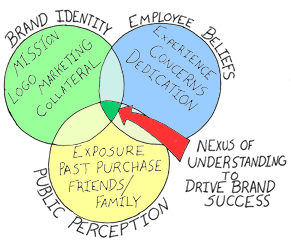Brand Perceptions
 Beyond the image you intend to convey via your branding plan are the two audiences which determine your success: the public and your employees. Understanding the perceptions of audiences is vital to brand and communication success. One person can see things one way and another can perceive the same thing differently. Understanding the perceptions of customers and employees helps you align your communication more clearly.
Beyond the image you intend to convey via your branding plan are the two audiences which determine your success: the public and your employees. Understanding the perceptions of audiences is vital to brand and communication success. One person can see things one way and another can perceive the same thing differently. Understanding the perceptions of customers and employees helps you align your communication more clearly.
Take a look at the following picture, for example, what do you see?
 What do you see here?
What do you see here?
Some people see a young woman looking away from the canvas while others see an old woman looking down. It is the same picture, but perception can change based on who is viewing it. In similar manners, brand perceptions can be different for various audiences.
Here we have a few examples of work we've conducted that focuses on both how brands are perceived and what factors impact employee satisfaction.
------------------------------
Regional Healthcare System: Market Perspectives
6-week quantitative; Piedmont NC
Key Questions:
- in a highly competitive market with several top-tier healthcare institutions, how do market members perceive a local brand, evaluate its competitive value, and make a decision to elect for treatment at that institution over others?
- how do members of the market interpret brand positioning; does their perception align with the intended message?
Outcome:
- targeted insights delivered in writing and in person to senior staff and administrators, allowing for brand realignment and understanding
- core themes of perceptions regarding competitive positioning of the brand in relation to competitors, including aspects of the brand which most resonate with key market segments
------------------------------
Regional Healthcare System: Staff Perspectives
8-week qualitative; Piedmont NC
Key Questions:
- why have employee satisfaction scores gone down? what are the key points of dissatisfaction?
- how can the institution advance their policies and systems in order to create stronger, more sustainable satisfaction across departments and levels of employment?
- what features and benefits of the institution drew in physicians and how can recruitment be improved to ensure superior staff presence and qualifications?
Outcome:
- themed insights presented via paper and in-person presentations gave a clear and consistent voice to the doctors and staff working at the institution, demonstrating unexpected insights regarding where communication difficulties and deficiencies were strongest and how to remedy those areas through strategic shifts in operations and communication
- results of research were presented to all administrators at entire institution over a series of weeks and physicians, who had felt their voices were rarely heard, were given summary documents which demonstrated the commitment of administration to improving the areas in which challenges had been identified
